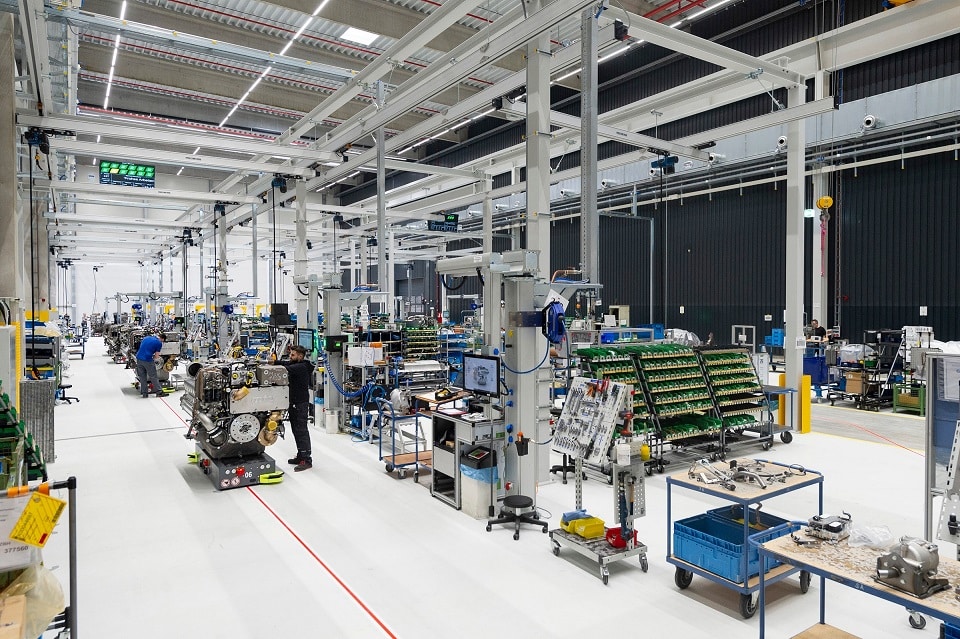Aerospace
Rolls-Royce officially opens €30m mtu combustion engine assembly plant in Germany

The MTU Series 2000 engine assembly facility for Rolls-Royce has begun operations in Kluftern, Germany, not far from Friedrichshafen. This emphasizes how the internal combustion engine will continue to play a part in the energy transition by using sustainable fuels.
A mid-double-digit million-euro investment in the future of this technology went into the new production facility, which makes room for shipping and assembly. In order to modernize the current assembly halls in Rolls-Royce’s Plant 2 in Friedrichshafen, which will provide long-term manufacturing space for the Series 4000 engine, the assembly of MTU Series 2000 engines will be moved to Kluftern. 110 persons are currently employed by the Kluftern factory.
Rolls-Royce successfully tests mtu engines with pure hydrogen(Opens in a new browser tab)
The new production facility has been built to be extremely energy- and environmentally friendly. An intelligent building control system in conjunction with other equipment measures will ensure energy-efficient operation, as will a 1.2 MW-peak photovoltaic system that delivers green electricity, e-charging columns that offer clean mobility options, and so on. Rolls-Royce is demonstrating its dedication to the Power Systems facility in Friedrichshafen with this investment.
Rolls-Royce is focusing on developing engines that can run on a wide range of sustainable fuels, replacing fossil fuels and significantly reducing carbon dioxide emissions. In addition, the company has already launched hybrid systems for rail, shipping and energy, as well as intelligent automation systems. This will enable us to provide climate-friendly propulsion technologies in the future for applications from commercial ships, yachts, land and rail vehicles to energy systems where complete electrification is not an optimal solution in the long-term.
Airbus and CFM International to pioneer hydrogen combustion technology(Opens in a new browser tab)
Rolls-Royce has previously released a large number of mtu engines that can run on this eco-friendly fuel. HVO helps reduce CO2 emissions by up to 90% while also cutting particle and nitrogen oxide emissions.

Aerospace
Boeing Transfers Rocket Stage to NASA, Paving Way for Human Moon Mission

Boeing has achieved a significant milestone by providing NASA with the second core stage of the Space Launch System (SLS) rocket.
This crucial component, crafted at NASA’s Michoud Assembly Facility (MAF), is set to propel the Artemis II crew into lunar orbit, marking humanity’s return to deep space after a 50-year hiatus.
The monumental Boeing-built rocket stage, the largest element of the Artemis II mission, will embark on a journey aboard the Pegasus barge, traveling 900 miles to NASA’s Kennedy Space Center.
Comparison of two legendary aircraft B777x vs B747 aircraft:Click here
Upon arrival, it will be meticulously integrated with other essential Artemis II components, including the upper stage, solid rocket boosters, and NASA’s Orion spacecraft within the iconic Vehicle Assembly Building. This intricate integration process is a vital step toward the eagerly anticipated Artemis II launch, slated for 2025.
“Boeing-built products helped land humankind on the moon in 1969, and we’re proud to continue that legacy through the Artemis generation,” remarked Dave Dutcher, vice president and program manager for Boeing’s SLS program. “Together, with NASA and our industry partners and suppliers, we are building the world’s most capable rocket and paving the way to deep space through America’s rocket factory in New Orleans.”
NASA, Lockheed Martin Reveal X-59 Quiet Supersonic Aircraft:Click here
The delivery of Core Stage 2 marks a significant achievement in the evolution of the SLS rocket. Towering over 200 feet and powered by four RS-25 engines, this core stage, coupled with two solid-fueled booster rockets, will generate a staggering 8.8 million pounds of thrust. This immense power is crucial to launching Artemis II and future missions into the vast expanse of space.
The SLS rocket stands unparalleled in its capability to transport both crew and substantial cargo to the moon and beyond in a single launch. Its extraordinary capacity will facilitate the delivery of human-rated spacecraft, habitats, and scientific missions to destinations including the moon and Mars, ushering in a new era of space exploration.
-

 Travel1 week ago
Travel1 week agoAir India to Expand US Operations with Three New Routes After a Decade
-

 Travel2 weeks ago
Travel2 weeks agoWhy We Should Avoid These Stamps in a Passport
-

 Airlines1 month ago
Airlines1 month agoInvestigations Reveal Fake Chinese Titanium in Boeing and Airbus Jets
-

 Tech4 weeks ago
Tech4 weeks agoChina’s CATL Plans 1,800-Mile Electric Plane Launch by 2027
-

 Airport3 days ago
Airport3 days agoTop 10 Largest Airports in the World by Size
-

 Aerospace4 weeks ago
Aerospace4 weeks agoChina’s Fighter Jets Turn Wings into Autonomous Drones
-

 Airlines4 days ago
Airlines4 days agoAir India Rolls Out A350s for Delhi-New York JFK and Newark Routes
-

 Defence3 weeks ago
Defence3 weeks agoBoeing Enhances Chinook with New Engines and Block II Upgrades at $96 Million







